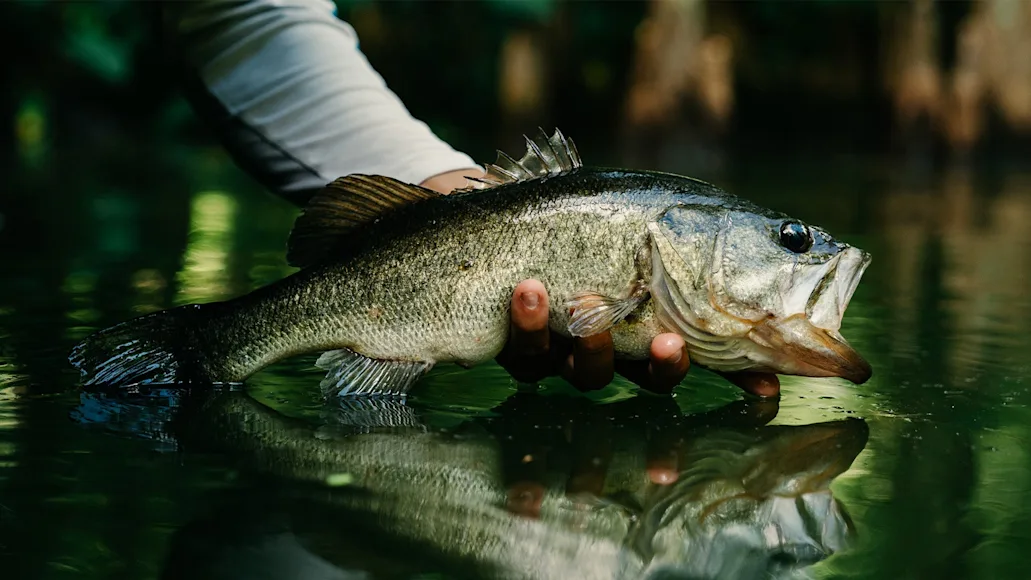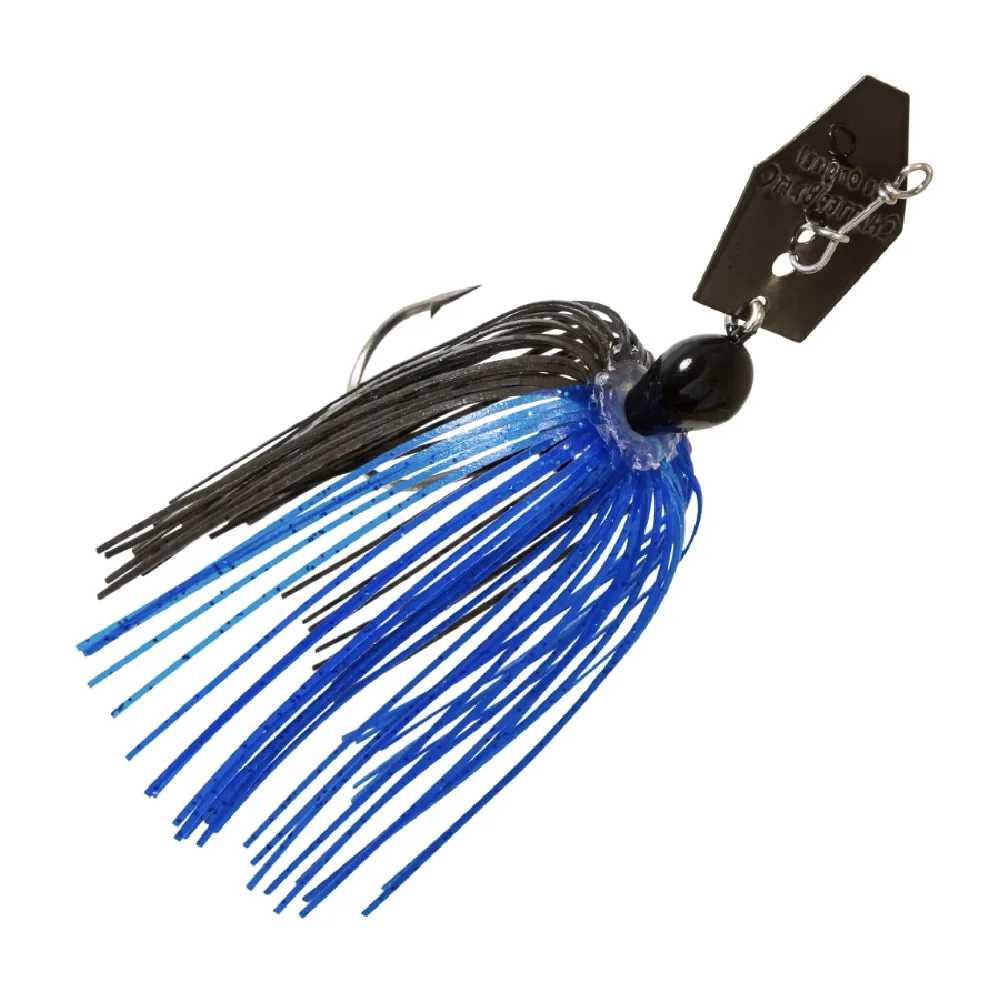We may earn revenue from the products available on this page and participate in affiliate programs. Learn more ›
If you’re interested in learning how to fish a chatterbait, then you probably already have some basic knowledge about this effective bass lure. One of the more revolutionary baits to come along, Z-Man’s Original Chatterbait spawned a whole new genre of bass fishing lure in the vibrating jig. For such a game-changing lure, there’s nothing too complicated about a chatterbait when you’re looking at it. Below, we cover everything about this style of bass lure—how the lure is built, how it works in the water, and some tips on how to fish a chatterbait.
Table of Contents
How to Fish a Chatterbait
Add Action to the Lure
Where Chatterbaits Work Best
How to Skip a Chatterbait
The Basic Parts of a Chatterbait
How to Pick the Right Chatterbait Lure
Best Lure Colors for Chatterbaits
Best Trailers for Chatterbaits
Final Thoughts on How to Fish a Chatterbait

How to Fish a Chatterbait
As effective and revolutionary as a chatterbait is, it’s also very easy to learn how to fish it. Any angler can tie a chatterbait on, throw it out, simply reel it in with a steady retrieve and catch a fish. Of course, as with any bass lure, there are some nuances when it comes to fishing chatterbaits.
1. Add Subtle Actions to the Lure
A chatterbait naturally has a very erratic action, meaning it dips, darts, and dives all over the place, even on a steady retrieve. And though this action alone is part of what turns bass on, you can add a little pump and pause to the mix and really step up your game.
Twitching your rod tip periodically while fishing baits like a spinnerbait, squarebill, or swim jig adds a little burst and flare to the bait. This is likely interpreted by a trailing bass as the supposed prey being aware of its pursuit. So these little sudden movements that are out of the norm often trigger a strike. This same principle holds true with chatterbaits.
2. Where Chatterbaits Work Best
Like a chatterbait, vibrating jigs work well on fisheries with shoreline and submerged vegetation. Bass love to hunker down in submerged vegetation like hydrilla, milfoil, and coontail. This bait comes through these grasses fairly well, making it a great selection. And if the bait begins to get bogged down a bit, it can be easily ripped free. Similarly to twitching a chatterbait, this sudden burst of action often has the added benefit of drawing a strike from a trailing bass.
3. How to Skip a Chatterbait
Vibrating jigs are also relatively easy to skip—and being able to skip an aggressive bait into and under places where an angler can typically only present a worm or a jig opens up a whole new realm of possibilities. When a bass tucks back under a dock or an overhanging bush, it’s positioning itself in a protected place where it can ambush prey if it wants to, but also rest and recuperate.
The disturbance a chatterbait creates in the water and the flash of its blade also make it a great choice for low-visibility situations. Whether you’re fishing on cloudy days, in muddy water, or even at night, a chatterbait is a very effective selection. The sudden appearance of a bait skipping overhead—followed by the immediate vibration generated as a chatterbait starts to swim—is enough to initiate a strike first, ask questions later kind of reaction.

The Basic Parts of a Chatterbait
A chatterbait consists of a hexagonal shaped blade attached to the eye of a jighead. The blade is almost always made of metal, and the jighead almost always has a skirt on it—though a few variations differ from these norms. Lastly, some sort of wire line tie is attached to the center of the blade.
When you fish a chatterbait, the result of this combination of metal and silicone comes alive when you reel it through the water. As a chatterbait fights its way forward, the blade gives way to one side to shed the resistance of the water, only to max out in that direction and be forced to go in the opposite direction. This rocking of the blade creates a vibration that runs up the line, down the rod, and through the spine of the angler.
This aggressive action is very effective at triggering a strike from a bass. Since bass use their lateral lines to hunt, which sense vibration, the disturbance alone makes a vibrating jig easy for them to target. But add in the erratic action and the flash of the blade, and now there’s a visually appealing presentation as well that mimics injured and fleeing prey.
How to Pick the Right Chatterbait Lure
When you’re first learning how to fish a chatterbait, you’ll soon see that the massive selections of options are nearly endless. And that is just taking into consideration one brand. When you add in the dozens of other companies that offer their variation of a vibrating jig, picking the right one can seem a little overwhelming. So, for the purposes of this beginner’s guide, we’ll keep things simple.
Best Lure Colors for Chatterbaits
An angler can do a whole lot with a simple 1/2-ounce Z-Man Original Chatterbait. This is a strong option built with solid components and a stout hook. As long as you have this lure in just three colors—chartreuse and white, shad, and green pumpkin—you’ll have something capable of catching a bass given dozens of different sets of conditions.
Chartreuse and White
The chartreuse and white option is meant more for mimicking shad and other lighter colored baitfish. It works really well in stained to clear water on cloudy days, and in stained to muddy water given both sunny and cloudy conditions. The vibrancy of this skirt color reflects a lot of light and makes it easier for a bass to track it down in these situations.
Shad Pattern
When bass are targeting shad in clearer water, the more translucent shad patterns work better. The somewhat see-through characteristic of the skirt material used with most of the shad color patterns keeps the bait from standing out too much in clear water, making it a little more realistic.
Green Pumpkin
Green pumpkin works really well in stained to clear water situations, around vegetation in particular. This color mimics small bluegill and other bream that live in and around submerged vegetation on lakes like Lake Guntersville in Alabama. But when moving farther south into the Florida lakes, an angler can add a gold flake swimbait as a trailer and use a green pumpkin chatterbait to imitate one of the more prevalent prey categories on many of those lakes, golden shiners.

Best Trailers for Chatterbaits
Now we shift our focus in this guide on how to fish a chatterbait to trailer selection. It’s not a good idea to fish a chatterbait without some sort of soft plastic bait. Again, there’s a lot to choose from. This is another great place to lean on simplicity in order to not get overwhelmed. Though grubs, split tails, and other trailers work on ChatterBaits, the two main categories that we’ll focus on are craws and swimbaits.
Craw Trailers for Chatterbaits
Using a craw, like a NetBait Mini Kickin’ B, gives a vibrating jig added action on the backend and helps to mask the hook. But perhaps even more importantly, it changes the way you can fish the bait. A chatterbait with no trailer will dip on the retrieve as it sinks into the water a little.
Adding a craw-style trailer gives the bait more width by effectively adding two little wings to the back of the bait. This creates lift for a vibrating jig, so the bait rises in the water column on the same speed of a retrieve that would allow it to sink, if no trailer was present.
This makes a craw-style trailer a great selection when you want to fish the bait particularly slow, like in cold water. Or when you want it to ride higher in the water column, like trying to get it to tick the tops of submerged vegetation.
Swimbait Trailers for Chatterbaits
Swapping over to a slender, paddle tail swimbait like a MISSLE Baits Shockwave still masks the hook and adds action to the back of the bait, but now the bait can sink down a little farther in the water column.
A good example of when to choose between a craw and a swimbait trailer would be transitioning from fishing a chatterbait in submerged vegetation that is two feet below the surface versus grass that’s topping out six feet below the surface.



